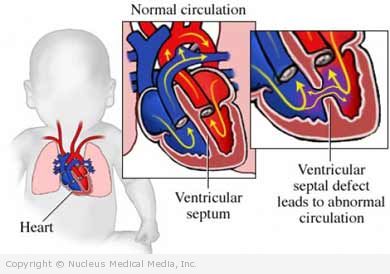Tetralogy of Fallot
Tetralogy of Fallot – Definition
Tetralogy of Fallot (TOF) is a combination of four heart defects. It is present at birth. These defects make it difficult for your child to get oxygen to the entire body.
The four defects are:
- Ventricular septal defect (VSD) — A hole in the heart. It is on a wall that separates the two lower chambers.
- Transposition — A major blood vessel (aorta) is in the wrong place.
- Pulmonary stenosis — The valve in the heart that allows blood to pass from the heart toward the lungs is too narrow.
- Right ventricular hypertrophy — The muscle on the right side of the heart is too thick.
VSD and transposition can decrease the amount of oxygen in the blood. This makes it difficult for the body to get the oxygen it needs. Pulmonary stenosis and right ventricular hypertrophy can make it difficult for blood to pass to the lungs. This will also decrease the amount of oxygen in the blood.
Tetralogy of Fallot – Causes
The child’s heart develops very early in pregnancy. Tetralogy of fallot is caused by a problem during this development. It is not known exactly why these problems happen. Some have been associated with genetics, mother’s nutrition or infections. Most have no known cause.
Tetralogy of Fallot – Risk Factors
Factors that may increase the risk of TOF, including:
- Mother’s exposure to thalidomide
- Mother’s alcohol use
- Mother has infection with rubella
Some people who have TOF also have a chromosome disorder. This may include Down syndrome.
Tetralogy of Fallot – Symptoms
For most, symptoms will appear during the first few weeks of life. For children with mild TOF, symptoms may not appear until much later. They may not show until your child or young adult becomes more active. Physical activity places more demand on the heart. A heart with TOF can not keep up with the extra demand. This will make symptoms appear. Without treatment, symptoms will continue to occur.
Symptoms may include:
- Loud heart murmur — a sound caused by chaotic blood flow through the heart, can be heard through a stethoscope
- Blue coloring of the skin and lips caused by a low oxygen level in the blood
- Shortness of breath and rapid breathing — caused by a low oxygen level in the blood
- Older children may have shortness of breath and fainting spells when they exercise.
In severe cases, a tetralogy spell may occur. This happens when the oxygen level in the blood drops suddenly. Symptoms include:
- Lips and skin become very blue
- Baby will become breathless and irritable
- Baby may become sleepy or unconscious if low oxygen levels continue
- Older children may squat with their knees on their chest to help recover from the breathlessness
Tetralogy of Fallot – Diagnosis
A diagnosis of TOF is often made very soon after birth. The doctor will ask about your child’s symptoms and the mother’s medical history. A physical exam will be done.
The doctor may begin tests based on your child’s symptoms. A newborn with blue skin will often be given extra oxygen. If the oxygen does not help, a heart defect may be suspected. If the skin color is normal, the first clue is a loud heart murmur.
If a heart defect is suspected, tests may include:
- Chest x-ray — a test that uses radiation to take a picture of structures inside the chest
- Echocardiogram — a test that uses sound waves to examine the size, shape, and motion of the heart
- Cardiac catheterization — a tube-like instrument is inserted through a blood vessel into the heart to detect problems with the heart
Tetralogy of Fallot – Treatment
Medications may be given to relieve symptoms. They may also help to prevent complications like the tetralogy spell.
The defects of the heart are treated with surgery. Surgical options include:
Temporary Operation
Small infants with severe TOF may not be strong enough for a complete repair surgery. A temporary operation will help increase the amount of oxygen in the blood. This will give the baby time to grow, get stronger and prepare for a complete repair.
During this operation a temporary, new path is made for the blood. The blood will be sent past the problems in the heart and go directly to the lungs. This will increase the amount of blood getting to the lungs. The oxygen in the blood will increase as a result.
Complete Repair
Most children with TOF have open-heart surgery within the first few years of life. The operation includes:
- Closing the hole in the heart. A patch will be placed over the hole.
- Improving the flow of blood from the heart to the lungs by one or more of the following:
- Removing some of the thickened heart muscle on the right side of the heart
- Repairing or replacing the valve that allows the blood to flow from the heart to the lungs
- Increasing the size of the blood vessels that carry blood to the lungs
For some, a path is created between the heart and the blood vessels to the lungs.
In many cases, the surgery is successful. For some further surgery may be needed. Long-term follow-up is always needed to detect recurring or new problems.
Tetralogy of Fallot – Prevention
There are no guidelines for preventing TOF.

